Cold works insidiously, dehydrating you, lowering your core temperature, and chilling your extremities. This creates the potential for injuries like dehydration, frostbite, hypothermia, and afterdrop, which can become quite serious if allowed to progress too far. Understanding how to prevent these winter injuries and learning some first aid you can use to keep mild cases in check is a good first step in staying safe during cold-weather activities.
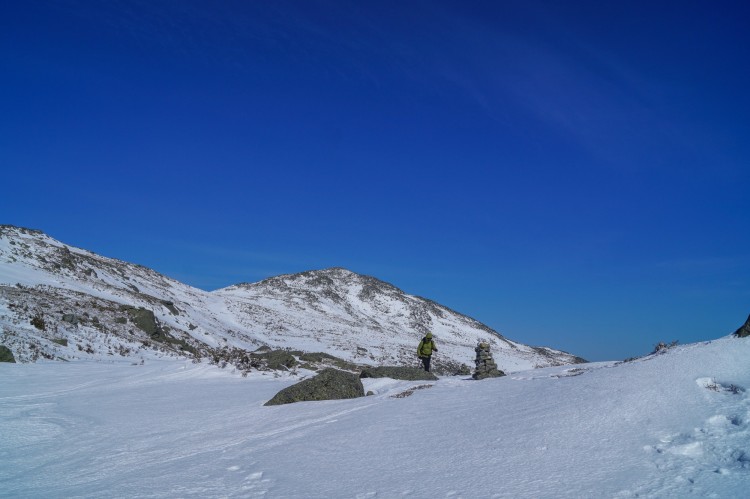
Snowshoeing in the notoriously cold northern Presidentials can present winter injury risk. Photo: Tim Peck and Doug Martland
Some of the links in this article may contain affiliate links. When you purchase using these links, part of the proceeds go to Snowshoe Mag. Additionally, as Amazon Associates, we earn from qualifying purchases. Please see our disclosure for more details.
Dehydration
Dehydration is something that almost every outdoor athlete experiences at one time or another, especially when recreating outside during the colder months. Simply put—when we exercise, we lose water through sweating (to cool us off) and breathing (to moisten cold air). This process is particularly true during high-exertion or long-duration activities like snowshoeing. In fact, a study by the University of New Hampshire found that cold weather increases the risk of dehydration.
Snowshoers should care about dehydration for two main reasons. First, dehydration impacts us physically, increasing fatigue and reducing mental capacity. Second, dehydration increases our susceptibility to other common winter injuries like frostbite, hypothermia, and altitude sickness. It also ups our chances of suffering a more severe injury in the backcountry.
Read More: Top 5 Safety Tips for Snowshoeing
Signs of Dehydration
Common early signs and symptoms of dehydration are fatigue, thirst, irritability, dizziness, dark urine, headache, lack of energy, and lack of appetite. As dehydration advances, additional signs and symptoms are a rapid pulse, weakness and nausea, loss of balance, changes in mental awareness, and, eventually, delirium and/or loss of consciousness.
Preventing Dehydration
Prevention is the key to avoiding dehydration, and it begins well before the first water break of your outing.
Start Early
So start your day by hydrating before you leave for the trailhead and again while you are on your way there; a bottle of water for the car is a great way to accomplish this (even if it means you have to pee when you get to the trailhead).
Take Regular Breaks
Once you start snowshoeing, plan on regular hydration breaks, such as stopping once an hour, to ensure that your internal reservoir is not getting too depleted. Since thirst is a poor indicator of hydration level (it tends to diminish as you become dehydrated), plan on consuming at least 0.25 liters (8.5 oz) per hour.
Use an Appropriate Carrier
One sure way to increase your chances of dehydration while snowshoeing is to let the valuable fluids you’re carrying freeze. A good thermos or insulated water bottle carrier can help prevent this, as can starting your day with a thermos or water bottle full of hot beverages. Also, beware that those hydration bladders, while popular in warmer weather, are prone to freezing—even those with insulated hoses.
Read More: Hydro Flasks for the Cold, Hot, and Snuggly
Don’t Run Out
Another way to increase your chances of dehydration is to run out of fluids. This may be inevitable on longer trips like a full-day snowshoe trek—you can only carry so much water. Remember that there might be places to refill your bottles in the backcountry. You should tap those sources when you find them, whether purifying running water or bringing a stove (read our review of MSR’s XGK EX Stove) to melt snow for your group.
Read More: What To Bring When Snowshoeing: Top Accessories for the Day Hiker
Treating Dehydration
If someone in your party starts getting dehydrated, the treatment for mild dehydration is straightforward: have them drink fluids to replace the ones they’ve lost.
Water, a diluted Gatorade mix, or water mixed with an electrolyte tab like the GU Hydration Tablets (read our GU review) are all great options and something every snowshoer should consider consuming after a day on the trails. A severely dehydrated person may need treatment in a hospital.
Read More: Nutrition for Winter Activities: A Beginner’s Guide
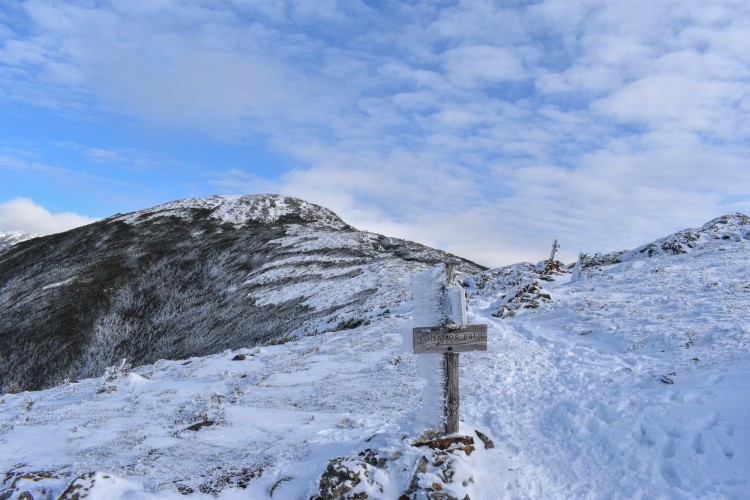
Remember to stay hydrated, even if not thirsty, especially on frigid days like this one in New Hampshire’s southern Presidentials. Photo: Tim Peck and Doug Martland
Frostnip
Frostnip is a localized cold injury that results from the constriction of small blood vessels in response to cold. It is a relatively minor injury that does not involve the freezing of or permanent damage to the tissue.
Common on the ears, nose, fingers, and toes, frostnip is identified by tingling and yellowish or grayish skin tone. Treatment is straightforward: rewarm the affected body part. This strategy is typically enough to resolve the problem.
Frostbite
Frostbite is a more complicated problem, as it involves the actual freezing of the affected tissue. It is most common on the extremities farthest from the body’s largest heat-generating muscles. The extremities can be in exposed locations, like the nose, ears, and cheeks. Frostbite in these areas is largely caused because your body, due to cold conditions, constricts blood flow to the extremities to keep the body’s core warm.
Frostbite damages tissue in several ways—it leads to the formation of ice crystals, which can damage tissue; the reduction in the now-frozen water changes the concentration of critical elements at the cellular level; and the eventual thawing of the ice crystals causes further tissue damage. In addition, hypothermia, which causes the same blood-shunting response as frostbite, increases a person’s likelihood of frostbite.
The degree of frostbite largely depends on how deeply the cold injury penetrates the body. There are three main categories:
- Superficial: the injury extends only to the top layer of the skin.
- Partial thickness: the injury impacts the upper layers of the skin.
- Full thickness: the injury affects all the skin’s layers as well as muscle and bone; potentially quite severe.
Read More: Book Review: Hypothermia, Frostbite, and Other Cold Injuries
Signs of Frostbite
Signs and symptoms of frostbite include pain in the affected area (potentially followed by numbness in more severe cases), a change in tissue consistency (normal to soft and pliant to hard and woody), and skin discoloration (normal to white and waxy to red or pale).
Preventing Frostbite
Prevention is key to avoiding frostbite. Stay hydrated and well-fueled. Wear appropriate layers, like gloves, insulated boots, and face coverings. Also, swap out wet items for dry items, so they don’t freeze, which will further conduct heat away from your extremities.
On cold days, prioritize regularly checking in with your snowshoeing partners about their hands and toes. And observe their faces; you’re in a better position than them to notice.
Read More: Keep Your Hands, Feet, and Head Warm for Snowshoeing
Treating Frostbite
Treatment for frostbite is rapid rewarming in a warm-water bath in a sheltered environment. That said, rapid rewarming isn’t always feasible in the field. As such, in more severe cases, caution should be used before rewarming, as the pain in the rewarmed tissue may be so bad that the patient cannot self-evacuate, leading to potentially more significant problems, including the tissue re-freezing. More severe cases of frostbite require prompt medical attention.
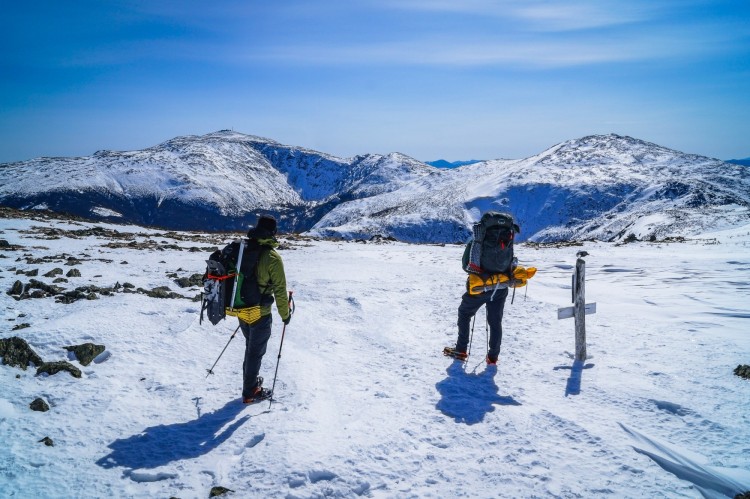
Two hikers are taking in the view of Mount Washington, home to “the world’s worst weather.” Best to be prepared if the conditions worse. Photo: Tim Peck and Doug Martland
Hypothermia
Hypothermia occurs when the body’s heat loss exceeds heat gain, and the core temperature drops below 95 degrees. It has three general categories, each defined by core body temperature—mild (93-95 degrees), moderate (86-93 degrees), and severe (below 86).
Signs of Hypothermia
Hypothermia manifests both mentally and physically.
Mental signs and symptoms include reduced decision-making ability, lethargy, increased complaints, disorientation, and slurred speech.
Physical signs and symptoms include loss of fine motor skills and decreased heart rate and respirations—in addition to shivering, at least initially. A patient progressing from mild hypothermia to a more advanced stage of hypothermia, however, loses the ability to shiver.
Read More: Book Review: Hypothermia, Frostbite, and Other Cold Injuries
Preventing Hypothermia
Preventing further heat loss is the first step in treating a person with mild or moderate hypothermia.
Remove the person’s wet clothes and give them warm, dry clothing. Next, get the person insulated from the ground, out of the elements, and, if possible, into a shelter. Then actively rewarm the person using a combination of warm hydration, heat sources (e.g., hot water bottles near the core arteries), sleeping bags, and a “hypo wrap” (think multiple sleeping bags with a vapor barrier that prevents evaporative heat loss and keeps the insulation dry).
The required measures are directly dependent on the person’s condition; dry layers and natural shivering will often be enough to address minor cases.
Read More: Before Snowshoeing Alone, Ask Yourself These Questions
Treating Hypothermia
Treating more advanced cases of hypothermia in the field is much more complicated because the patient won’t be able to rewarm themselves spontaneously. Such cases require prompt medical attention, and patients in transit should be handled gently because jostling increases the likelihood that a cold, slowly beating heart experiences ventricular fibrillation.
As with most cold injuries, hypothermia is much easier to prevent than treat. Hydrate well, fuel regularly, wear appropriate layers (i.e., a raincoat when it’s raining), and be cautious around bodies of water, as wind, precipitation, and immersion can all increase the risk of hypothermia.
Read More: Winter Hiking Safety 101: A Beginner’s Guide for Hikers and Snowshoers
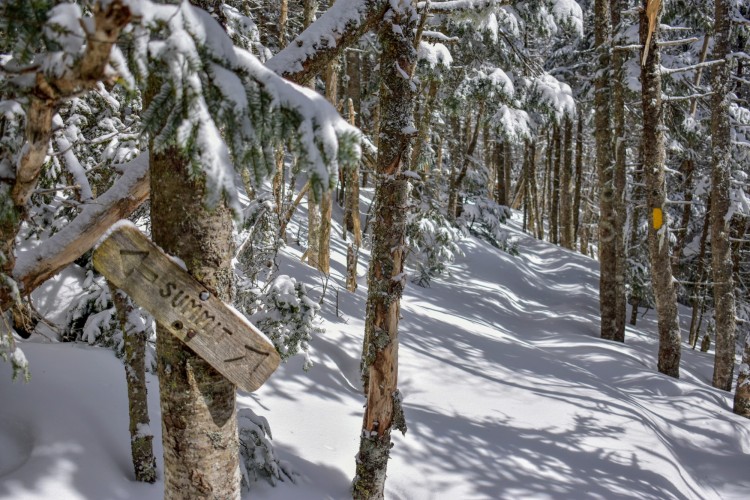
Full winter conditions in New Hampshire’s White Mountains. Ensure to stay warm and prevent winter injuries by wearing the appropriate layers. Photo: Tim Peck and Doug Martland
Afterdrop
There’s one final winter cold-related injury to worry about: afterdrop. Defined as the continued drop in core temperature even once out of the cold, afterdrop is caused by the return of cold blood to the body’s core.
Treatment is to continue to warm the patient. But be aware that severe cases require medical attention, as shock and cardiac arrest can result.
Overall
As you can see, cold injuries can be pretty serious and ruin an otherwise great day on the trails. So the next time out, take the fundamental steps mentioned above to prevent dehydration, frostbite, hypothermia, and afterdrop.
Have you experienced any cold weather injuries? What recommendations do you have? Please share your thoughts with us in the comments below.
Read Next: Safety First: Snowshoeing Hazards and How To Avoid Them

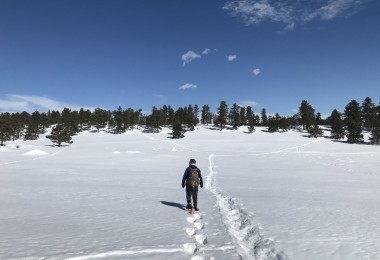
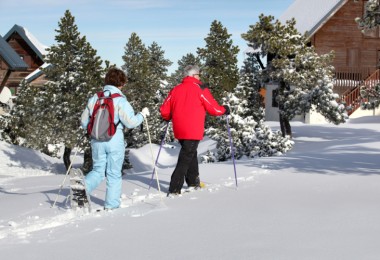
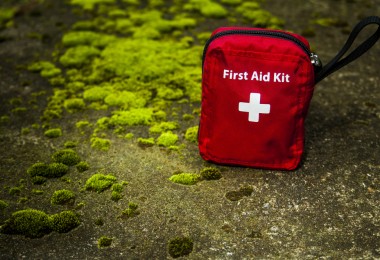
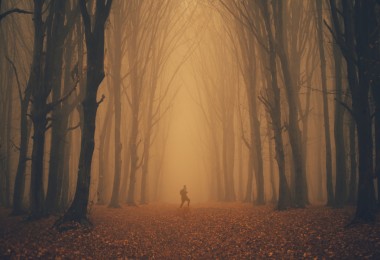

Article does not mention sharing body heat to warm up a person